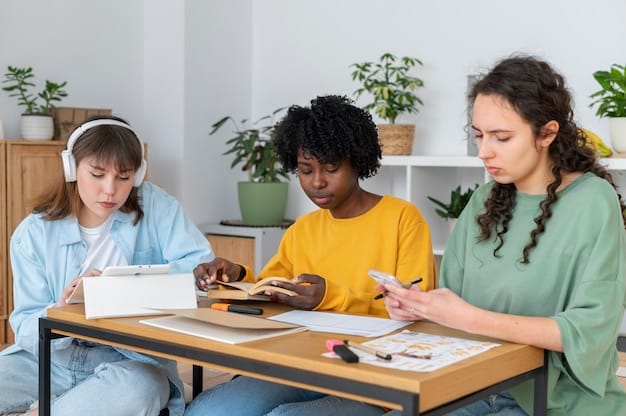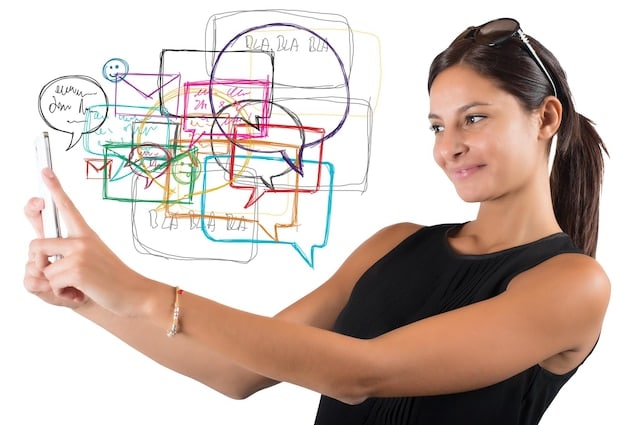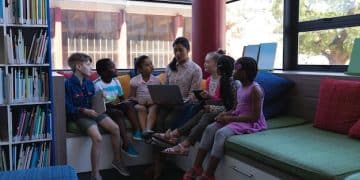Boost Motivation: How Learning Styles Impact Engagement

The impact of learning styles on motivation and engagement is significant, as understanding and catering to individual learning preferences can foster a more focused and inspired educational experience, leading to enhanced academic outcomes.
Discover how understanding the impact of learning styles on motivation and engagement can revolutionize your learning experience. Tailoring your approach to match your unique learning style can unlock focus and keep you inspired.
Understanding Learning Styles and Their Influence
Learning styles refer to the different ways individuals process and retain information. Recognizing these styles is crucial for educators and learners alike to optimize the learning process and boost motivation.
By understanding how different learning styles work, educators can create more inclusive and effective teaching strategies. This understanding also enables students to take control of their learning and choose methods that best suit their individual needs.
Defining Learning Styles
Learning styles categorize individuals based on their preferred methods of absorbing, processing, and retaining information. These styles can be broadly classified into visual, auditory, kinesthetic, and reading/writing preferences.
- Visual Learners: These individuals learn best through visual aids such as charts, diagrams, and videos.
- Auditory Learners: They prefer listening to lectures, participating in discussions, and using audio recordings.
- Kinesthetic Learners: Hands-on experiences, experiments, and physical activities are most effective for them.
- Reading/Writing Learners: These learners excel by reading texts and taking detailed notes.
Ultimately, understanding the impact of learning styles on motivation and engagement is fundamental to creating a learning environment that caters to the personalized needs of each student.

The Connection Between Learning Styles and Motivation
Motivation in learning stems from the alignment between the learning environment and an individual’s preferred learning style. When students find the learning process engaging and enjoyable, their motivation naturally increases.
When learning activities align with individual preferences, students are more likely to stay focused, retain information, and actively participate. This positive feedback loop fosters a deeper connection with the subject matter.
How Different Learning Styles Affect Motivation
Each learning style has unique characteristics that affect how motivated an individual feels during the learning process. Recognizing these differences can help educators and learners tailor their approach.
For visual learners, engaging with colorful diagrams and videos can be more motivating than reading lengthy texts. Auditory learners may find motivation by listening to podcasts or participating in group discussions, while kinesthetic learners are motivated by hands-on activities that allow them to physically interact with the material.
The connection between motivation and learning styles highlights the impact of learning styles on motivation and engagement, stressing the importance of personalized learning strategies.
Strategies to Enhance Focus Based on Learning Styles
Improving focus involves creating an environment that complements an individual’s learning style. When the learning environment matches their preferences, students are more likely to stay engaged and absorb information effectively.
Effective strategies include adapting study materials, utilizing technology, and incorporating breaks that cater to individual needs. By employing these techniques, learners can overcome distractions and maintain concentration.
- Visual Learners: Use color-coded notes, mind maps, and video tutorials to enhance focus.
- Auditory Learners: Record lectures, participate in study groups, and create mnemonic devices to improve concentration.
- Kinesthetic Learners: Take frequent breaks to move around, use stress balls, and engage in hands-on activities while studying.
- Reading/Writing Learners: Summarize notes, rewrite key concepts, and create outlines to stay focused.
Thus, adapting teaching methods to suit various learning styles can greatly enhance focus and motivation, underscoring the impact of learning styles on motivation and engagement.
Creating an Engaging Learning Environment Tailored to Learning Styles
An engaging learning environment is one that is adaptable, diverse, and inclusive. It takes into account the varying learning styles of students and provides resources that cater to each preference.
Tools and resources such as interactive whiteboards, multimedia presentations, group discussion forums, and hands-on experiment kits can create a dynamic and engaging atmosphere.
Practical Examples for Different Learning Styles
Consider a science class where the topic is the water cycle. For visual learners, diagrams and animated videos illustrating the stages of the cycle can be very effective. Auditory learners can benefit from a sing-along song or a group discussion explaining the process.
Kinesthetic learners can participate in a hands-on experiment that involves setting up a miniature water cycle in a terrarium. Reading/writing learners can summarize key steps and vocabulary in a written report.
Creating an engaging and inclusive learning environment is paramount to enhancing focus and inspiration, highlighting the impact of learning styles on motivation and engagement in education.

The Role of Technology in Supporting Different Learning Styles
Technology offers a wide array of tools and resources that can cater to various learning styles. From interactive simulations to online collaborative platforms, technology can enhance the learning experience for all students.
Virtual reality (VR) and augmented reality (AR) can provide immersive kinesthetic learning experiences. Educational apps and software can offer personalized learning paths that adapt to individual needs and preferences.
Utilizing Digital Tools to Cater to Learning Styles
Consider using online resources to supplement traditional teaching methods. Visual learners can benefit from interactive infographics and animated explainers. Auditory learners can utilize audiobooks, podcasts, and online lectures to reinforce concepts.
Kinesthetic learners can explore virtual labs and simulations that allow them to experiment without physical constraints. Reading/writing learners can use online writing tools and collaborative documents to summarize and share their insights.
Ultimately, the application of technology in education can cater to varied learning styles, thereby amplifying the impact of learning styles on motivation and engagement.
Overcoming Challenges and Staying Inspired
Even with the best strategies, learners may encounter challenges such as distractions, lack of resources, or moments of burnout. Overcoming these challenges requires self-awareness, adaptability, and a supportive learning community.
Strategies for staying inspired include setting achievable goals, celebrating small victories, and maintaining a positive mindset. Engaging with peers, seeking feedback, and regularly reassessing learning strategies can also boost motivation.
- Stay Organized: Use a planner, prioritize assignments, and manage time effectively to avoid feeling overwhelmed.
- Create a Study Routine: Establish a consistent study schedule and stick to it as much as possible.
- Take Breaks: Prevent burnout by taking regular breaks to recharge and refocus.
- Seek Support: Don’t hesitate to ask for help from teachers, classmates, or tutors when you need it.
Therefore, fostering an environment of self-awareness and support is integral in sustaining motivation, underscoring the impact of learning styles on motivation and engagement.
Real-Life Examples of Successful Implementation
Many educational institutions and educators have successfully implemented strategies that cater to different learning styles. These success stories demonstrate the positive impact of personalized learning on student motivation and achievement.
Case studies reveal that schools that adopt inclusive teaching practices often see improved academic outcomes, increased student engagement, and a more positive school culture. These examples provide valuable insights and inspiration for educators looking to implement similar approaches.
In one instance, a school introduced a “learning lab” where students could choose different learning stations based on their preferred styles. Visual learners engaged with interactive displays, auditory learners participated in group discussions, and kinesthetic learners worked on hands-on projects. The results were significant improvements in test scores and student satisfaction.
These real-world applications exemplify the impact of learning styles on motivation and engagement, validating the importance of customized learning experiences.
| Key Point | Brief Description |
|---|---|
| 💡 Learning Styles | Different ways individuals process and retain information. |
| 🎯 Engagement | Motivation and focus increase when learning matches style. |
| 🛠️ Strategies | Adapt methods to styles for enhanced focus and motivation. |
| 🚀 Technology | Digital tools support diverse learning needs and preferences. |
FAQ
▼
The main types of learning styles include visual, auditory, kinesthetic, and reading/writing. Each style involves a unique way of processing information. Visual learners prefer charts and diagrams, while auditory learners thrive on lectures.
▼
You can identify your learning style through online quizzes, self-reflection, and paying attention to how you best absorb information. Consider what types of study materials you find most effective and engaging.
▼
Catering to different learning styles enhances engagement, motivation, and information retention. When students learn in ways that resonate with them, they are more likely to succeed and enjoy the learning process.
▼
Yes, technology offers a wide range of tools that cater to various learning styles. From interactive simulations for kinesthetic learners to audiobooks for auditory learners, technology provides personalized learning experiences.
▼
Educators can create inclusive environments by using diverse teaching methods, offering various resources, and encouraging student feedback. Adapting lessons to suit multiple learning styles fosters a more engaging classroom.
Conclusion
Understanding and catering to different learning styles not only enhances motivation and engagement but also cultivates a lifelong love of learning. By adapting strategies to suit individual needs, educators and learners can unlock their full potential and achieve greater success. The impact of learning styles on motivation and engagement is profound, and its application offers immense benefits in any learning context.





